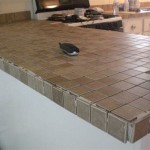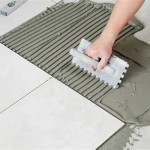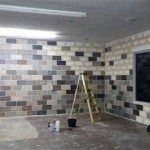Can You Put Tile On Sheetrock In Bathroom Wall? A Comprehensive Guide
The feasibility of installing tile directly onto sheetrock in a bathroom environment is a common question among homeowners and contractors alike. The bathroom presents unique challenges due to its inherent moisture levels and fluctuating humidity. Whether sheetrock, also known as drywall, can adequately support tile and withstand these conditions hinges on numerous factors, including preparation, materials, and adherence to best practices.
This article elucidates the considerations, potential pitfalls, and necessary steps involved in tiling over sheetrock in a bathroom setting. It aims to provide a clear understanding of when it might be acceptable, when it is strongly discouraged, and what alternatives exist to ensure a durable and long-lasting tile installation.
Understanding the Limitations of Standard Sheetrock in Bathrooms
Standard sheetrock, while a ubiquitous building material, is not inherently moisture-resistant. It is composed primarily of gypsum, a porous material that readily absorbs water. In a bathroom, this absorption can lead to a cascade of problems. First, the sheetrock itself can become weakened and structurally compromised. This can manifest as softness, crumbling, or even complete failure. Second, the bond between the tile adhesive (thin-set mortar) and the sheetrock can weaken, leading to loose or falling tiles. Third, trapped moisture can foster mold and mildew growth, creating an unhealthy environment and potentially causing significant damage to the underlying structure of the wall.
The weight of the tile is another critical factor. Standard sheetrock may not be able to bear the load of larger or heavier tiles, especially over time. The constant pull of gravity, combined with the weakening effects of moisture, can exacerbate the risk of failure.
Therefore, simply applying thin-set and tile directly to standard sheetrock in a bathroom is generally not recommended and can lead to costly repairs down the line. The risks associated with moisture damage and structural inadequacy far outweigh any perceived convenience.
When Tiling Over Sheetrock Might Be Considered (With Stringent Precautions)
While tiling directly over standard sheetrock is generally discouraged, there are limited circumstances where it *might* be considered, provided specific and rigorous precautions are taken. These circumstances are usually confined to areas with minimal water exposure, such as a small backsplash area far from the shower or tub. However, even in these seemingly benign situations, careful assessment and preparation are paramount.
The first crucial step is to ensure the existing sheetrock is in pristine condition.
This means it must be completely dry, free of any mold or mildew, and structurally sound. Any signs of water damage, even minor staining, are red flags indicating a need for replacement or remediation. The sheetrock should be firmly attached to the wall studs, with no loose screws or popped nails. Any imperfections should be addressed before proceeding.The second critical factor is the application of a high-quality, waterproof membrane.
This membrane acts as a barrier, preventing moisture from penetrating the sheetrock. It must be applied meticulously, according to the manufacturer’s instructions, ensuring complete coverage and proper sealing of seams and edges. There are various types of waterproof membranes available, including liquid-applied membranes and sheet membranes. Liquid-applied membranes are typically applied with a roller or brush, while sheet membranes are adhered to the wall with thin-set mortar.The third precaution involves the size and type of tile.
Small, lightweight tiles are less likely to overstress the sheetrock. Avoid using large-format tiles or natural stone tiles, which are considerably heavier. Choosing a high-quality thin-set mortar specifically designed for use with waterproof membranes is also essential.Even with these precautions, it's crucial to understand that tiling over standard sheetrock in a bathroom remains a high-risk endeavor. The long-term durability and performance of the installation are not guaranteed, and the potential for failure remains significant. In most cases, it is far more prudent and cost-effective to opt for a more robust substrate designed for wet environments.
Recommended Alternatives: Moisture-Resistant Substrates for Bathroom Walls
Given the inherent limitations of standard sheetrock in bathrooms, the use of moisture-resistant substrates is strongly recommended. These materials are specifically engineered to withstand the challenges of high humidity and water exposure, providing a far more reliable and durable foundation for tile installations. Several excellent alternatives are available, each offering its own advantages.
Cement board:
Cement board, such as Durock or HardieBacker, is a highly durable and water-resistant substrate made from cement, sand, and reinforcing fibers. It is specifically designed for use in wet areas and provides an excellent surface for tiling. Cement board is resistant to mold, mildew, and rot, and it can withstand prolonged exposure to moisture without degrading. It is relatively heavy and can be somewhat challenging to cut and install, but its superior performance makes it a worthwhile investment.Waterproof drywall:
Certain types of drywall are specifically manufactured to be water-resistant or even waterproof. These products, often referred to as green board or blue board, have a moisture-resistant coating that helps to protect the gypsum core from water damage. While they offer improved resistance compared to standard sheetrock, they are not as robust as cement board and are generally recommended for areas with moderate water exposure, such as walls surrounding a sink. It is imperative to clarify if the intended product is "water-resistant" or truly "waterproof" as the terms are frequently used interchangeably, leading to potential misapplication.Waterproof panels:
Numerous manufacturers offer purpose-built waterproof panels specifically designed for use in showers and bathrooms. These panels are typically made from closed-cell foam or other waterproof materials and are incredibly lightweight and easy to install. They often feature interlocking edges, creating a seamless and waterproof surface. While they may be more expensive than cement board or water-resistant drywall, their ease of installation and superior performance make them a popular choice for many homeowners and contractors.Applying a Waterproof Membrane Over Existing Sheetrock:
If removing the existing sheetrock isn't feasible, another option is to apply a waterproof membrane over it. As stated earlier, this membrane acts as a barrier, preventing moisture from penetrating the sheetrock. However, it is essential to ensure that the existing sheetrock is structurally sound and free of any moisture damage before applying the membrane. Any damaged areas should be repaired or replaced. This approach is generally less desirable than replacing the sheetrock with a moisture-resistant substrate, as it relies on the integrity of the existing sheetrock. It's also crucial to choose a high-quality membrane specifically designed for use in wet environments and to follow the manufacturer's instructions meticulously.When selecting a substrate, consider the level of water exposure, the size and weight of the tile, and the overall budget. Ultimately, choosing a moisture-resistant substrate is a crucial step in ensuring a long-lasting and trouble-free tile installation in a bathroom.
Proper Installation Techniques for Tile Over Any Substrate
Regardless of the substrate chosen, proper installation techniques are paramount to a successful and durable tile installation. This includes meticulous surface preparation, the selection of appropriate adhesives, and careful application of the tile.
Surface preparation:
The substrate must be clean, dry, and free of any loose debris or contaminants. This may involve scraping, sanding, or cleaning the surface with a suitable cleaner. Any imperfections, such as cracks or holes, should be repaired before proceeding. For cement board, it is often recommended to apply a thin layer of thin-set mortar to the surface to fill any minor imperfections and improve adhesion.Adhesive selection:
Choosing the correct thin-set mortar is crucial. For most bathroom tile installations, a modified thin-set mortar is recommended. These mortars contain polymers that enhance their adhesion, flexibility, and water resistance. Select a thin-set specifically designed for use with the chosen substrate and type of tile. Always follow the manufacturer's instructions regarding mixing ratios and application techniques.Tile application:
Apply the thin-set mortar to the substrate using a notched trowel, creating even ridges. Press the tile firmly into the mortar, ensuring good contact. Use tile spacers to maintain consistent grout lines. Regularly check the level and alignment of the tiles. After the mortar has cured, apply grout to fill the joints between the tiles. Select a grout that is resistant to moisture and mold. Seal the grout with a grout sealer to further protect it from water penetration.Proper installation techniques are just as important as selecting the right materials. Taking the time to prepare the surface properly, choose the appropriate adhesives, and apply the tile carefully will ensure a long-lasting and beautiful tile installation.
What Happens If You Tile Over Drywall In A Shower Quora

Tile Over Drywall Showers A Common But Bad Practice Scott Hall Remodeling

Can You Tile Over Drywall Master Building Materials Blog

Can You Tile Over Drywall Master Building Materials Blog

How To Tile Over Sheetrock Doityourself Com

Replace Bathroom Drywall With Tiled Walls Fix It Handyman

The Complete Guide To Installing Tile On Shower Or Bathtub Walls

Waterproof Bathtub Shower Walls Over Drywall

How To Prep A Wall For Tile

Tiling With Mussel Bound Honey Built Home
Related Posts








